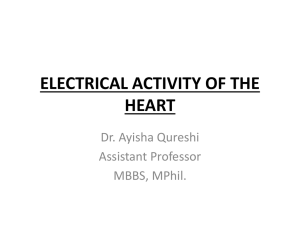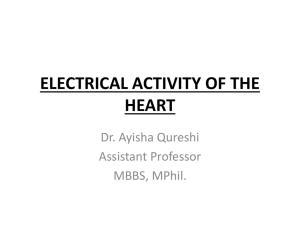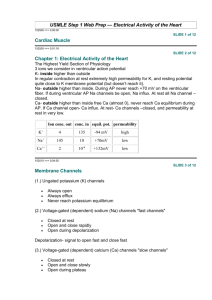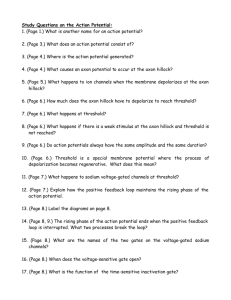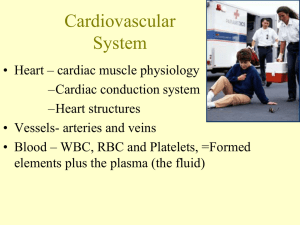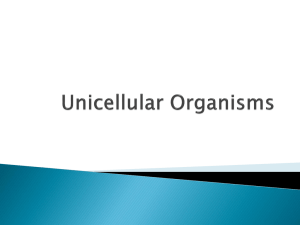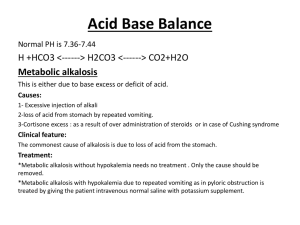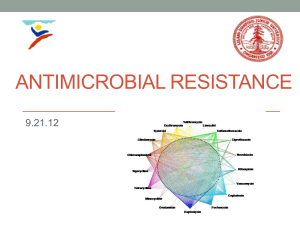Electrical Activity of Heart
advertisement
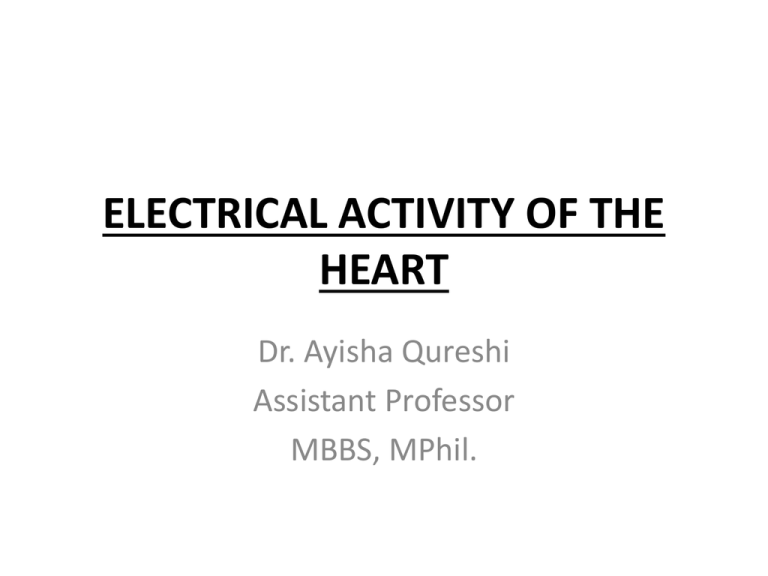
ELECTRICAL ACTIVITY OF THE HEART Dr. Ayisha Qureshi Assistant Professor MBBS, MPhil. Cardiac cells contract without Nervous Stimulation. • Cardiac muscle, like skeletal muscle & neurons, is an excitable tissue with the ability to generate action potential. • Most cardiac muscle is contractile (99%), but about 1% of the myocardial cells are specialized to generate action potentials spontaneously. These cells are responsible for a unique property of the heart: its ability to contract without any outside signal. • The heart can contract without an outside signal because the signal for contraction is myogenic, originating within the heart itself. • The heart contracts, or beats, rhythmically as a result of action potentials that it generates by itself, a property called auto rhythmicity (auto means “self”). • The signal for myocardial contraction comes NOT from the nervous system but from specialized myocardial cells also called auto rhythmic cells. • These cells are also called pacemaker cells because they set the rate of the heart beat. THE MYOCARDIUM • Two specialized types of cardiac muscle cells: • Each of these 2 types of cells has a distinctive action potential. CARDIAC MUSCLE Contractile 99% Autorrythmic 1% Electrical Activity of the Heart • Myocardial Auto rhythmic cells (1%) – These cells are smaller and contain few contractile fibers or organelles. Because they do not have organized sarcomeres, they do not contribute to the contractile force of the heart. • Myocardial Contractile cells (99%) Contractile cells which include most of the heart muscle – Atrial muscle – Ventricular muscle These cells contract and are also known as the Working Myocardium. Action Potential of the Autorrythmic cardiac cells • The auto rhythmic cells do not have a stable resting membrane potential like the nerve and the skeletal muscles. • Instead they have an unstable membrane potential that starts at – 60mv and slowly drifts upwards towards threshold. • Because the membrane potential never rests at a constant value, it is called a Pacemaker Potential rather than a resting membrane potential. What causes the membrane potentials of these cells to be unstable? • Auto rhythmic cells contain channels different from other excitable cells. • When cell membrane potential is at -60mv, channels are permeable to both Na and K. • This leads to Na influx and K efflux. • The net influx of positive charges slowly depolarizes the auto rhythmic cells. This leads to opening of Calcium channels. • This moves the cell more towards threshold. When threshold is reached, many Calcium channels open leading to the Depolarization phase. IONIC BASIS OF ACTION POTENTIAL OF AUTORRYTHMIC CELLS Phase 1: Pacemaker Potential: • Opening of voltage-gated Sodium channels called Funny channels (If or f channels ). • Closure of voltage-gated Potassium channels. • Opening of Voltage-gated Transienttype Calcium (T-type Ca2+ channels) channels . Phase 2: The Rising Phase or Depolarization: • Opening of Long-lasting voltagegated Calcium channels (L-type Ca2+ channels). • Large influx of Calcium. Phase 3: The Falling Phase or Repolarization: • Opening of voltage-gated Potassium channels • Closing of L-type Ca channels. • Potassium Efflux. ACTION POTENTIAL OF A CONTRACTILE MYOCARDIAL CELL:A TYPICAL VENTRICULAR CELL • Unlike the membranes of the autorrythmic cells, the membrane of the contractile cells remain essentially at rest at about -90mv until excited by electrical activity propagated by the pacemaker cells. ACTION POTENTIAL OF A CONTRACTILE MYOCARDIAL CELL:A TYPICAL VENTRICULAR CELL • Depolarization - Opening of fast voltage-gated Na+ channels. Rapid Influx of Sodium ions leading to rapid depolarization. • Small Repolarization - Opening of a subclass of Potassium channels which are fast channels. Rapid Potassium Efflux. • Plateau phase - 250 msec duration (while it is only 1msec in neuron) - Opening of the L-type voltage-gated slow Calcium channels & Closure of the Fast K+ channels. - Large Calcium influx - K+ Efflux is very small as K+ permeability decreases & only few K channels are open. • Repolarization - Opening of the typical, slow, voltage-gated Potassium channels. Closure of the L-type, voltage-gated Calcium channels. Calcium Influx STOPS Potassium Efflux takes place. Summary of Action Potential of a Myocardial Contractile Cell • • • • Depolarization= Sodium Influx Rapid Repolarization= Potassium Efflux Plateau= Calcium Influx Repolarization= Potassium Efflux Action Potentials of different cardiac cells:
